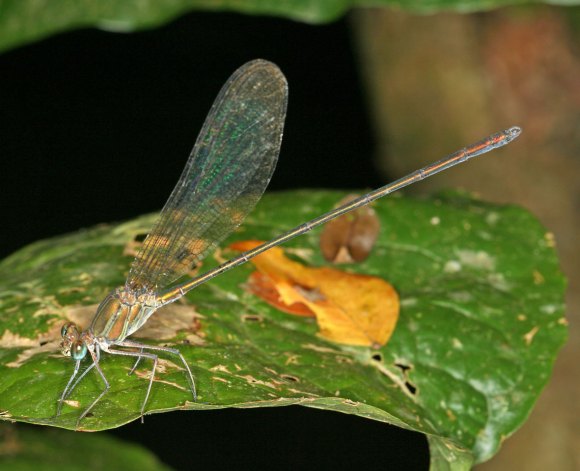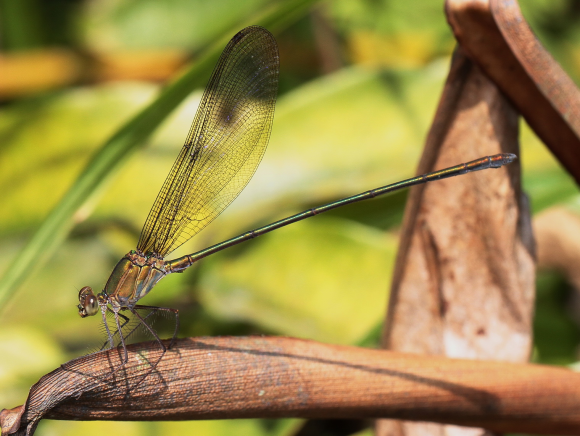Genus Phaon Selys, 1853
African demoiselles
Synonyms:
- scientific: Prophaon Fraser, 1941 [camereunica = camerunensis]
Type species: Calopteryx iridipennis Burmeister, 1839
Introduction
Endemic to tropical Africa, with two species, and a third in Madagascar. Both are large (hindwing 34-40 mm) and metallic green, marked with pale brown. They are named for their iridescent forewings that ‘flash’ on every beat, appearing more green or blue in P. iridipennis and violet in P. camerunensis, although P. iridipennis can be violet. P. camerunensis prefers forested streams and rivers and is often deeply green; the brownish areas along the thoracic sutures are narrower than the green areas in-between. The nearly ubiquitous P. iridipennis is duller; the brownish and green areas are about equally wide. Despite liking some cover (e.g. gallery vegetation), it also inhabits open rivers and seasonal streams. The two are occasionally found together. [Adapted from Dijkstra & Clausnitzer 2014]
Diagnosis
Like Umma and Sapho separated from other damselflies by (a) face not swollen; (b) 3 or more Ax; (c) arculus halfway between base and node, or more proximal; (d) quadrilateral with 5-9 cross-veins; (e) Abd slender, reaches well beyond wing tips. However, differs by (1) labium at least partly pale, rather than all black; (2) humeral and interpleural sutures with broad pale borders separating metallic areas, rather than enclosed in metallic areas and with at most with pale traces; (3) Fw discoidal field of 1 cell-row well distal to node and about 6 cells wide on wing border, rather than only well proximal to node and 15-25 cells wide on wing border; (4) base of anal vein directed away from rather than towards wing base.

Phaon iridipennis (Burmeister, 1839). Male © Hans-Joachim Clausnitzer

Phaon camerunensis Sjöstedt, 1900. Male © Jens Kipping
Map citation: Clausnitzer, V., K.-D.B. Dijkstra, R. Koch, J.-P. Boudot, W.R.T. Darwall, J. Kipping, B. Samraoui, M.J. Samways, J.P. Simaika & F. Suhling, 2012. Focus on African Freshwaters: hotspots of dragonfly diversity and conservation concern. Frontiers in Ecology and the Environment 10: 129-134.
References
- Dijkstra, K.-D.B. (in prep). Odonata of the Congo: checklist, bibliography, gazetteer, new records, species descriptions, and taxonomic notes with an emphasis on Elattoneura, Mesocnemis and Congothemis. Zoologische Mededelingen. [PDF file]
- Dijkstra, K.-D.B, and Clausnitzer, V. (2014). The Dragonflies and Damselflies of Eastern Africa: handbook for all Odonata from Sudan to Zimbabwe. Studies in Afrotropical Zoology, 298, 1-264.
- Ris, F. (1921). The Odonata or Dragonflies of South Africa. Annals South African Museum, XVIII, 245-452. [PDF file]
- Pinhey, E.C.G. (1961). Dragonflies (Odonata) of Central Africa. Occasional Papers Rhodes-Livingstone Museum, 14, 1-97. [PDF file]
- Schouteden, H. (1934). Annales Musee Congo belge Zoologie 3 Section 2, 3, 1-84. [PDF file]
Citation: Dijkstra, K.-D.B (editor). African Dragonflies and Damselflies Online. http://addo.adu.org.za/ [2024-10-31].

